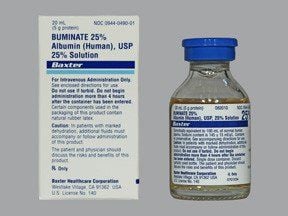This is an automatically translated article.
Albumarc drug is administered intravenously for patients with hypovolemia, hypoalbuminemia with edema,... During treatment with Albumarc, patients need to strictly follow the instructions of the doctor. to ensure safety and minimize side effects.1. What is Albumarc?
Albumarc is albumin intravenous solution, used to treat the following cases:
Treatment of hypovolemia; Hypoalbuminemia due to insufficient production of albumin by the body, breakdown of too much albumin, loss of albumin, or re-fractionation of albumin from the body; Albumin-lowering treatment for people with infections, pancreatitis or serious injuries that do not recover quickly despite nutritional supplements; Helps correct low osmotic pressure in the blood and helps to replace protein lost due to severe burns after the first 24 hours; Used as lining fluid for patients undergoing coronary artery bypass graft surgery; Treatment for persistent hypovolemia; Treatment of hypoalbuminemia accompanied by edema; Used in combination with certain other medications, such as water pills, to treat swelling of the fluid inside the lungs (interstitial pulmonary edema) and hypoproteinaemia in adults with respiratory failure (ARDS); Treatment of swelling in people with severe kidney failure who are taking steroids or water pills; Treatment of hemolytic disease (HDN) in neonates. Because Albumarc is used by intravenous infusion, patients are only allowed to take the drug under the direct supervision of a doctor.
2. Some things to note before using Albumarc
Before deciding to use Albumarc intravenous infusion, patients need to consider the benefits and risks that this drug may bring during treatment. For Albumarc, doctors and patients need to consider a few things:
Patient's allergies
You should tell your doctor if you have ever had any unusual or allergic reaction to with the active ingredient in Albumarc or other similar drugs. In addition, the patient should also inform the doctor about his or her allergy history to foods, preservatives, animals or dyes to prevent the risk of a reaction when intravenous infusion with Albumarc . For over-the-counter drugs, you need to read the labels carefully and look at the chemical ingredients in the medicine.
Pediatrics and geriatrics
There is not any specific information that shows that taking Albumarc can cause health problems in young children and the elderly. For these patients, the use of Albumarc requires close supervision of the physician and the injection of Albumin at an appropriate dose for body weight.
Pregnant or lactating women
There are not enough studies to determine the risks to pregnant women and their babies when using Albumarc. Before using Albumarc in this group of people, patients need to talk with their doctor carefully to weigh the potential benefits against the possible risks to ensure the safety of infusion.
3. Instructions on how to use Albumarc properly
3.1. How to use Albumarc Albumarc drug will be administered intravenously through a small needle placed into the patient's vein. Albumarc infusion will be done by a nurse or specialist to make sure the medication is safe and correct.
3.2. Albumarc Dosage: 5% albumin infusion dose for people with peritonitis, burns, pancreatitis, shock:
For adults: Initial dose is about 250 or 500ml IV at a rate of 1-2ml/min for in the absence of a shock reaction. The total infusion volume and 5% albumin infusion rate will be determined based on the patient's response and health status. If response is inadequate, an infusion dose of albumarc should be added over 15 to 30 minutes. For children: The starting dose is about 4.5 – 6.8ml/kg body weight. 25% albumin infusion dose for people with peritonitis, burns, pancreatitis, shock:
For adults: The initial dose is about 200-300ml IV to reduce edema and bring the serum protein level to normal. . Because these patients have approximately normal blood volumes, IV infusions of more than 100 mL within 30-45 minutes should not be given over 30 to 45 minutes to avoid circulatory overload. If a slower dose is desired, the physician can combine 200ml of 25% albumin with 300ml of 10% dextrose solution and continuous drip at a rate of 100ml/hour. For children: There is no recommendation for the use of 25% albumin. 3.3. Albumarc Dosage Adjustment When administering an undiluted 25% albumin solution to normal blood volume individuals at a sufficiently slow infusion rate of approximately 1 mL/min to prevent plasma volume expansion too rapidly.
The amount of albumin infusion and the duration of use in shock therapy should be based on the patient's response, degree of pulmonary obstruction, blood pressure, and hematocrit. If the patient continues to lose protein, the doctor can supply more with bags containing red blood cells.
For burn treatment Albumarc will be suggested within the first 24 hours. After this time, the patient will need more albumin, while less crystalloid solution to maintain electrolyte balance and prevent condensation. The duration of albumarc therapy can be adjusted based on the degree of loss of renally excreted protein and decreased albumin synthesis. Elevating the infusion level of albumin above 4g/100ml may increase the rate of catabolism.
4. Side effects of Albumarc drug During treatment with Albumarc, patients may experience some unwanted side effects. When any noticeable symptoms occur, the patient should report to the doctor for immediate medical attention, including:
Cough (may be accompanied by bubbling pink sputum), chest pain, difficulty swallowing; Dizziness, pale lips and fingernails; Shortness of breath, pale skin, fast heartbeat; Rash, red rash or hives on the skin; increased sweating, eyelid swelling, swelling around the eyes, lips, face, or tongue; Fatigue, blurred vision, chest discomfort; Swollen feet or ankles; Chills, confusion, lightheadedness, or fainting; fever, nausea, vomiting, headache, pain in the jaw, arm, neck, or back; Loss or change in taste. These side effects may occur differently in each patient and may disappear during treatment with Albumarc when the body has adapted to the drug. In addition, your doctor can also instruct you on some ways to help prevent or reduce the presence of these side effects.
5. What precautions should be taken when using Albumarc? In the process of using A lbumarc intravenous infusion, patients need to be cautious of the following:
Blood or urine tests before Albumarc infusion to check for unwanted effects; Albumarc can cause a serious allergic reaction (anaphylaxis) and should be treated quickly because it can be life-threatening. You should tell your doctor if you experience itching, rash, trouble breathing, trouble swallowing, hoarseness or swelling of your face/mouth/hands after taking this medicine. Albumarc can increase blood volume or cause blood thinning, which can lead to an overload of the blood vessels, heart, and lungs. This condition is often characterized by symptoms such as chest pain, shortness of breath, headache, lightheadedness, dizziness, or bulging varicose veins. Tell your doctor right away if you experience blurred vision, change in color perception, blood in your urine, chest pain, chest discomfort, headache, irregular heartbeat/breathing, low back pain, facial swelling, shortness of breath, fatigue, nausea, vomiting, or unusual weakness after infusion of albumarc. Because Albumarc is made from donor blood, some products can contain viruses and pass them on to the recipient. However, the risk of this happening is relatively low. To reduce the risk of virus transmission, both blood donors and donated blood are tested for the virus. 6. Albumarc drug interactions 6.1. What drugs does Albumarc interact with? Some drugs when used together with Albumarc can lead to interactions and cause dangerous side effects for patients. To find out if Albumarc can interact with any other drugs, patients need to discuss specifically with their doctor. In addition, you should also tell your healthcare professional about any medications you are taking, including OTC drugs, prescription drugs, supplements, herbs or vitamins, etc. prevent drug interactions.
6.2. Interactions of the drug Albumarc with food / alcohol / tobacco Some drugs are not recommended to be taken with or near the time of eating because it can occur. Using tobacco and alcohol with Albumarc can also potentially interact. Ideally, patients should talk to their doctor about taking Albumarc with alcohol, tobacco or food.
6.3. Health problems that may affect the use of Albumarc In fact, some health conditions can change or affect how Albumarc is used. You should tell your doctor if you have any of the following:
Are allergic to N-acetyl birdptophan and sodium caprylate; Severe anemia; Heart failure (normal or increased blood volume); Have bleeding problems such as internal bleeding; Hypertension ; CKD; Esophageal varices ; Pulmonary edema (with caution when administering albumarc intravenously as it may increase the risk of hemolysis or hypervolemia).
Please dial HOTLINE for more information or register for an appointment HERE. Download MyVinmec app to make appointments faster and to manage your bookings easily.
Reference sources: drugs.com , holevn.org












